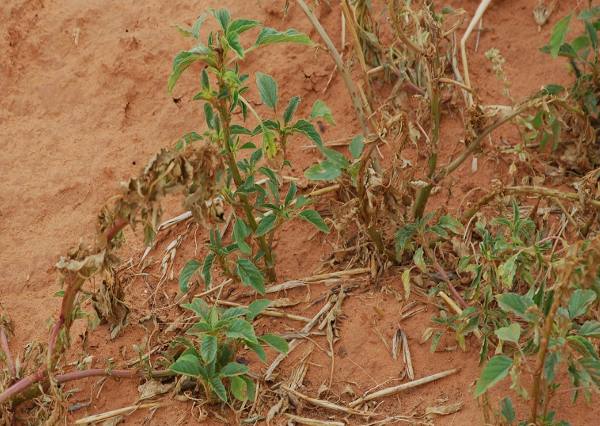
Dealing with Palmer amaranth—pigweed—is nothing new for the Texas High Plains. It’s always claimed the number one spot on the list of weed problems for cotton farmers.
So developing a program to deal with glyphosate resistant pigweed should not become the nightmare that has bedeviled cotton and soybean farmers in the Mid-South and the Southeast, says Wayne Keeling, Texas AgriLife agronomist and weed scientist who works out of the Lubbock Research and Extension Center.
Keeling discussed resistant-weed management recently at the South Plains Ag Conference and Trade Show in Brownfield. Morningglory and Russian thistle also claim spots near the top of the most troublesome weed list for High Plains producers.
“Johnsongrass is not as much of a problem in the High Plains anymore,” he said.
Keeling said most farmers (91 percent) in the region relied on preplant incorporated herbicides before the Roundup Ready era. Also, 20 percent used a pre-emergence herbicide and 40 percent spot-sprayed and almost everyone cultivated to control weeds.
“Yellow herbicides and cultivation were the keys,” Keeling said.
Adoption of Roundup Ready technology offered significant benefits to High Plains farmers, he said. “We greatly reduced silverleaf nightshade, for instance. Roundup Ready accomplished a lot of good, but we may have become too reliant on Roundup.” That reliance selected for resistant pigweed survival. “And pigweed produces a lot of seed. But the good news is we can control pigweed. We have a lot of good cotton herbicides.”
Identification of glyphosate resistance in the Texas High Plains is recent—2011. “They identified glyphosate-resistant Palmer amaranth in the Mid-South five or six years ago,” he said. “Farmers in the High Plains had been doing a lot of things right during that time, but we did see resistance begin to show up in 2011. We collected seed from some escapes, grew them out in the greenhouse and treated them with Roundup. At two times the recommended rate, we observed almost no control.
“We also asked for farmers to collect samples of suspected resistant pigweed. We got 12 samples from four or five counties and determined that eight of those samples were resistant. In 2012, we received more and more reports of weeds that farmers couldn’t kill.”
Prevention is key
Prevention, Keeling said, is the best strategy. Keys to prevention include:
Using herbicides with multiple modes of action.
Using soil residual herbicides.
Applying post-emergence tank-mix herbicide treatments.
Using sequential weed control techniques.
Going back to some tillage and cultivation.
Adopting new technology.
He said residual herbicides such as trifluralin or Prowl are critical to preventing herbicide-resistant weed infestations. Incorporation, either through tillage or irrigation, is necessary, he said.
Those pre-plant materials are important to control small broadleaf weeds and annual grasses. “Rate will be relative, depending on soil types,” Keeling said. “Heavier soils may require higher rates. Higher rates also may be needed if the material is incorporated with irrigation.
“The value of yellow herbicide application is evident in the field,” he said. “Tumbleweeds, for instance, are controlled with yellow herbicides.
Pre-emergence residual herbicides, materials such as Caparol, Direx, Cotoran, Dual and Staple, “can help with weeds the yellows don’t control. On sandy soils, Caparol is the only one I’m comfortable with,” Keeling said. “North of Lubbock, any of the others will do.”
He said Dual Magnum and Staple may offer a broader spectrum of control than the dinitroaniline herbicides. “But we may have some residual issues with Staple.”
Postemergence treatments options include Staple, Dual Magnum, Prowl H2O and a few others. Some can be tank-mixed with Roundup.
In some cases, cotton weed control “has come full circle, back to post-direct spray applications at lay-by.” Product options include Caparol, Direx, Cotoran, and Layby Pro, applied alone or with Roundup. These treatments offer residual pigweed and morningglory control.”
New technology may be another key to delaying herbicide resistant weed infestations, Keeling said. GlyTol Liberty Link technology, for instance, is tolerant to Liberty and Roundup herbicides.” Tank-mixing those herbicides, however, is not effective because of an antagonism effect.”
Roundup is not as effective on morningglory but does a better job on pigweed than Liberty. “If a farmer has both weeds a sequential approach is best,” Keeling said. “If morningglory is the worst problem, apply Liberty first then follow with Roundup.”
He said dicamba with glyphosate offers improved control of problem annual and perennial weeds as a burndown or as an in-season treatment. “It’s especially helpful with glyphosate-resistant pigweed.”
New technology with tolerance to dicamba and glyphosate may pose some drift issues, Keeling said. Nozzle selection may help. He recommends coarse to very coarse spray and ground-only application.
He said a new technology, Enlist weed control system, which enables plants to have tolerance to 2, 4-D, may be approved for corn and soybean production in 2014. Approval in cotton may be 2016. Keeling said trials have shown “no significant injury to cotton.”
But he expressed concern with drift with either the dicamba or 2, 4-D products.
Tillage practices also may play a role in herbicide resistance management, Keeling said. “Conservation tillage protects the soil (and seedlings) from blowing, but it complicates weed control. Weed control, residue management and stand establishment are all considerations with conservation tillage. It is important to kill small weeds.”
Keeling said identifying glyphosate resistant weeds in the Texas High Plains was not a welcome event but not necessarily a surprising one either. A history of battling Palmer amaranth and following sound weed control programs delayed the onset of resistance to some degree and cotton farmers’ experience with controlling pigweed at least gives them a head start on managing the problem
And new production techniques and technology will aid their efforts, Keeling said.
About the Author(s)
You May Also Like






